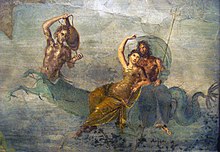| Salacia | |
|---|---|
| Goddess of salt water | |
 Centaur, Salacia and Neptune, fresco from Pompeii, AD 50–79 Centaur, Salacia and Neptune, fresco from Pompeii, AD 50–79 | |
| Abode | The Sea |
| Symbol | dolphin, seaweed |
| Mount | dolphin |
| Consort | Neptune |
| Offspring | Triton |
| Equivalents | |
| Greek | Amphitrite |


In ancient Roman mythology, Salacia (/səˈleɪʃə/ sə-LAY-shə, Latin: [saˈɫaːkia]) was the female divinity of the sea, worshipped as the goddess of salt water who presided over the depths of the ocean. Neptune was her consort. That Salacia was the consort of Neptune is implied by Varro, and is positively affirmed by Seneca, Augustine and Servius. She is identified with the Greek goddess Amphitrite, consort of Poseidon, or Tethys who was also a marine deity.
The god Neptune wanted to marry Salacia, but she was in great awe of her distinguished suitor, and to preserve her virginity, with grace and celerity she managed to glide out of his sight, and hid from him in the Atlantic Ocean. The grieving Neptune sent a dolphin to look for her and persuade the fair nymph to return and share his throne. Salacia agreed to marry Neptune and the King of the Deep was so overjoyed at these good tidings that the dolphin was awarded a place in the heavens, where he now forms a well known constellation Delphinus.
Salacia is represented as a beautiful nymph, crowned with seaweed, either enthroned beside Neptune or driving with him in a pearl shell chariot drawn by dolphins, sea-horses (hippocamps) or other fabulous creatures of the deep, and attended by Tritons and Nereids. She is dressed in queenly robes and has nets in her hair.
Salacia was the personification of the calm and sunlit aspect of the sea. Derived from Latin sāl, meaning "salt", the name Salācia denotes the wide, open sea, and is sometimes literally translated as "the salty one".
As his wife, Salacia bore Neptune three children, the most celebrated being Triton, whose body was half man and half fish.
Aulus Gellius, in 13.23 of his Attic Nights, notes that Roman priests would invoke specific attributes of various gods, “maia Volcani, Salacia Neptuni, hora Quirini, nerio Martis.” Forsythe notes that Salacia Neptuni means “effervescence of Neptune”.
Sometimes, as Salachia, she is also known as the goddess of springs, ruling over the springs of highly mineralized waters.
She and Venilia are also called the paredrae of Neptune.
Planetoid 120347 Salacia is named after the goddess.
Notes
- Gurney, Hudson (2008). The Works of Apuleius, Comprising the Metamorphoses, Or Golden Ass, the God of Socrates, the Florida, and His Defence, Or a Discourse on Magic. READ BOOKS.
- Manual of Mythology: for the use of schools, art students, and general readers founded on the works of Petiscus, Preller, and Welcker, Murray, A. S., Asher: 1873, Original from Oxford University, Digitized 19 Jan 2007
- Varro, De lingua Latina, v. 72, “Salacia Neptuni a salo.”
- Augustine, De civitate Dei, vii. 22, “Jam utique habebat Salaciam Neptunus uxoreum”; Servicius, on Virgil, Aen, x. 76, “Sane hane Veniliam quidam Salaciam accipiunt, Neptuni uxorem.”
- Adonis Attis Osiris: Studies in the History of Oriental Religion, Frazer, J. G., Edition: 3, Kessinger Publishing: 2003
- A Dictionary of Greek and Roman biography and mythology, Salacia
- "…Salacia, weighed down with her lapful of fish, with little Palaemon, their charioteer, upon a dolphin." Gurney, Hudson (2008). The Works of Apuleius, Comprising the Metamorphoses, Or Golden Ass, the God of Socrates, the Florida, and His Defence, Or a Discourse on Magic. READ BOOKS.
- "…Salacia, the folds of her garment sagging with fish" (Apuleius, The Golden Ass 4.31).
- Guerber, H. A. (1993). The Myths of Greece & Rome. Courier Dover Publications.
- "Sal - Wiktionary".
- A new classical dictionary of Greek and Roman biography, mythology and geography, partly based upon the Dictionary of Greek and Roman biography and mythology, Smith, W, Anthon, C, Published by Harper and brothers: 1862, Original from Harvard University, Digitized 6 May 2008
- Gods of Olympos Or Mythology of the Greeks and Romans, Petiscus, A.H., Translated by Katherine A. Raleigh, Published by Kessinger Publishing: 2003.
- Manual of Mythology: for the use of schools, art students, and general readers founded on the works of Petiscus, Preller, and Welcker, Murray, A. S., Asher: 1873, Original from Oxford University, Digitized 19 Jan 2007
- "LacusCurtius • Gellius — Noctes Atticae".
- A Critical History of Early Rome: From Prehistory to the First Punic War, Forsythe, G, Published by University of California Press: 2006
- Turner, P; Coulter, C. R. (2001). Dictionary of Ancient Deities. Oxford University Press US.
References
- Elseviers Mythologische Encyclopedie, van Aken, Dr. A.R.A., Elsevier, Amsterdam: 1961
- Vestal Virgins, Sibyls, and Matrons: Women in Roman Religion, Takács, S. A., University of Texas Press: 2007
- Bell's New Pantheon Or Historical Dictionary of the Gods, Demi Gods, Heroes and Fabulous Personages of Antiquity, Bell, J, Kessinger Publishing: 2003
- St. Augustin's City of God and Christian Doctrine: Nicene and Post-Nicene Fathers of the Christian Church Part 2, Augusti St Augustin, Saint Augustine, Bishop of Hippo, Published by Kessinger Publishing: 2004.
External links
 Media related to Salacia (mythology) at Wikimedia Commons
Media related to Salacia (mythology) at Wikimedia Commons
| Ancient Roman religion and mythology | ||
|---|---|---|
| Deities (Dii Consentes) |  | |
| Legendary figures | ||
| Legendary beings | ||
| Texts | ||
| Concepts and practices | ||
| Philosophy | ||
| Events | ||
| Objects | ||
| Variations | ||
| See also | ||